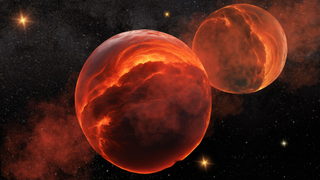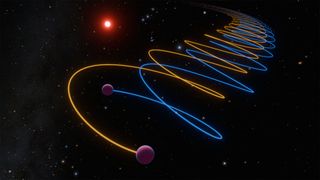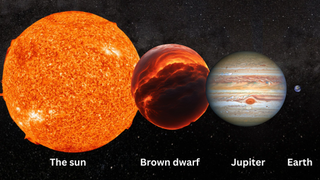These 'failed stars' orbit so closely it took 29 years to tell they were a pair
"Gliese 229B was considered the poster-child brown dwarf, and now we know we were wrong all along about the nature of the object. It's not one but two."

A well-studied cosmic object has stunned astronomers. The "failed star" Gliese 229B has been revealed to be two so-called "brown dwarfs" that are closely orbiting each other rather than just one.
The revelation means that Gliese 229B is a "first-of-its-kind" tight brown dwarf binary, increasing the hope other such exotic systems dwell in the Milky Way just waiting to be discovered. The finding also solves a long-standing mystery about Gliese 229B, explaining why this brown dwarf appears too dim for its mass.
"Gliese 229B was considered the poster-child brown dwarf," team member and California Institute of Technology (Caltech) researcher Jerry W. Xuan said in a statement. "And now we know we were wrong all along about the nature of the object. It's not one but two. We just weren't able to probe separations this close until now."
Brown dwarfs get their unfortunate nickname of "failed stars" because they form from collapsing clouds of gas and dust like "regular" stars but fail to gather enough mass from what remains of this cloud to trigger the fusion of hydrogen to helium in their cores. Gliese 229B is located 19 light-years away where it orbits a red dwarf called Gliese 229. In 1995, it became the first-known brown dwarf, introducing astronomers to failed stars. Now, fittingly, it introduces the new concept of incredibly close brown dwarf binaries.
You can forgive astronomers for failing to distinguish the two bodies of Gliese 229B, now designated Gliese 229Ba and Gliese 229Bb. They are separated by a distance of just 3.8 million miles (6.1 million kilometers). This might seem like an incredible distance, but to put that into perspective, it is just 16 times the distance between Earth and the moon and only around 4% of the distance between Earth and the sun. The two brown dwarfs of Gliese 229B are so tightly bound that they whirl around each other once every 12 Earth days.
Related: Alien weather report: James Webb Space Telescope detects hot, sandy wind on 2 brown dwarfs

The discovery, made by a team of astronomers from the California Institute of Technology (Caltech), means that Gliese 229B isn't a single object with around 70 times the mass of Jupiter, but two: One brown dwarf with around 38 times the mass of the solar system gas giant and another with around 34 Jupiter masses. Gliese 229 B's dual nature raises the question of how such tightly bound brown dwarf systems form.
Get the Space.com Newsletter
Breaking space news, the latest updates on rocket launches, skywatching events and more!
"This discovery that Gliese 229B is binary not only resolves the recent tension observed between its mass and luminosity but also significantly deepens our understanding of brown dwarfs, which straddle the line between stars and giant planets," team member and Caltech David Morrisroe Professor of Astronomy Dimitri Mawet said in the statement.
Finding the missing link
Brown dwarfs are fascinating for astronomers because, at least in terms of mass, they bridge the gap between the most massive planets and the least massive stars. These failed stars are generally considered to possess between 13 and 80 Jupiter masses.
Such a "missing link" between stars and planets had been theorized since the 1960s, but it took until the mid-1990s for astronomers to discover one (or two as we now know) in the form of Gliese 229B. A team, including Rebecca Oppenheimer, who was also part of the crew behind this new revelation, uncovered the failed star(s).
Oppenheimer is now a professor in the Department of Astrophysics at the American Museum of Natural History but was a Caltech graduate student in 1995. Alongside colleagues, Oppenheimer used the Palomar Observatory to discover that Gliese 229B possesses methane in its atmosphere. This is common to massive gas giant planets but not to stars, meaning that Gliese 229B's similarity to a star hinted at its nature as a missing link between planets and stars.
"Seeing the first object smaller than a star orbiting another sun was exhilarating," Oppenheimer said in the statement. "It started a cottage industry of people seeking oddballs like it back then, but it remained an enigma for decades."

In the three decades since the discovery of Gliese 229B, astronomers have intensely studied the system, finding that even for a failed star, it is too dim for its mass. This led scientists to theorize that Gliese 229B must be two brown dwarfs, not one. Yet, observation of this dual nature still escaped astronomers.
"To evade notice by astronomers for 30 years, the two brown dwarfs would have to be very close to each other," Xuan explained.
Xuan and colleagues were able to succeed where other astronomers had been foiled by turning to two different instruments, both installed at the Very Large Telescope (VLT) located in the Atacama Desert region of northern Chile. The GRAVITY interferometer allowed the researchers to spatially resolve Gliese 229B into two bodies, while the CRyogenic high-resolution InfraRed Echelle Spectrograph (CRIRES+) allowed them to detect spectra of light from both objects.
This latter tool revealed the redshift of one brown dwarf, the "stretching" of wavelengths of light that indicates an object is moving away from Earth, and the blueshift of the other failed star, a squashing of the wavelength of light indicating movement toward Earth.
Hence, the revelation of the brown dwarf duo Gliese 229Ba and Gliese 229Bb.
"These two worlds whipping around each other are actually smaller in radius than Jupiter. They'd look quite strange in our night sky if we had something like them in our own solar system," Oppenheimer said. "This is the most exciting and fascinating discovery in substellar astrophysics in decades."
Though the formation of close brown dwarf binaries is something of a puzzle, it is possible that the collapsing cloud of gas and dust that birthed these failed stars could have spilled into two, creating two brown dwarfs "seeds." These seeds could have then become gravitationally bound, leading to the birth of the Gliese 229B system, and others like it just waiting to be found.
"The fact that the first known brown dwarf companion is a binary bodes well for ongoing efforts to find more," Xuan added.
The team now aims to hunt more closely orbiting brown dwarf binaries with instruments such as the Keck Planet Imager and Characterizer (KPIC) located at the W. M. Keck Observatory in Hawai'i. They could also turn to the Keck Observatory's upcoming High-resolution Infrared SPectrograph for Exoplanet Characterization (HISPEC), which is currently under construction at Caltech.
"It is so nice to see that almost 30 years later, there has been a new development," said Shri Kulkarni, Caltech Professor of Astronomy and Planetary Science, who was not part of this team but was one of the original discoverers of Gliese 229B. "Now, this binary system stuns again."
The study of Gliese 229Ba and Gliese 229Bb were published in the journal Nature on Oct. 16.
Editor's note: Corrected (10.25.24) to reflect the fact that redshift is the stretching of wavelengths, while blueshift is the squashing of wavelengths of light.
Join our Space Forums to keep talking space on the latest missions, night sky and more! And if you have a news tip, correction or comment, let us know at: community@space.com.

Robert Lea is a science journalist in the U.K. whose articles have been published in Physics World, New Scientist, Astronomy Magazine, All About Space, Newsweek and ZME Science. He also writes about science communication for Elsevier and the European Journal of Physics. Rob holds a bachelor of science degree in physics and astronomy from the U.K.’s Open University. Follow him on Twitter @sciencef1rst.
-
Space Robot Wow! The illustration showing the size comparison is completely wrong! Jupiter is NOT half the diameter of the Sun, but closer to 1/10. So how big are the brown dwarfs in comparison?Reply -
Classical Motion Being an unbalanced rotation, after enough orbits, wouldn’t they end up where they began? Forming a larger longer orbit.Reply -
rod Reply
"An illustration shows a size comparison between the sun, a brown dwarf, Jupiter, and Earth (if you can spot it!). (Image credit: Robert Lea (created with Canva))"Space Robot said:Wow! The illustration showing the size comparison is completely wrong! Jupiter is NOT half the diameter of the Sun, but closer to 1/10. So how big are the brown dwarfs in comparison?
LoL Space Robot, good catch. Perhaps the map is not to scale :) -
billslugg It is customary to make size comparisons to scale. This is further evidence, in my book, Robert Lea is AI. His postings, as with all other news writers on this site, are riddled with errors that a human astronomer would instantly fix, but an AI would not know to fix. The TOTALLY wrong size comparison speaks volumes. Can Mr. Lea appear here to defend the cause of his error? Was it ignorance, an oversight, what? Some kind of computer glitch maybe? How did it get in here? Why do we have to put up with this kind of stuff? Where are the fact checkers?Reply -
RobLea Reply
Used a NASA diagram for reference. Shame people got so hooked up on an image. Any errors are "human errors" showing I'm not a machine.billslugg said:It is customary to make size comparisons to scale. This is further evidence, in my book, Robert Lea is AI. His postings, as with all other news writers on this site, are riddled with errors that a human astronomer would instantly fix, but an AI would not know to fix. The TOTALLY wrong size comparison speaks volumes. Can Mr. Lea appear here to defend the cause of his error? Was it ignorance, an oversight, what? Some kind of computer glitch maybe? How did it get in here? Why do we have to put up with this kind of stuff? Where are the fact checkers? -
Woody K "This latter tool revealed the redshift of one brown dwarf, the "squashing" of wavelengths of light that indicates an object is moving away from Earth, and the blueshift of the other failed star, a stretching of the wavelength of light indicating movement toward Earth."Reply
According to my information, from the observer's viewpoint, redshift is wavelength stretching, and blueshift is wavelength squashing.